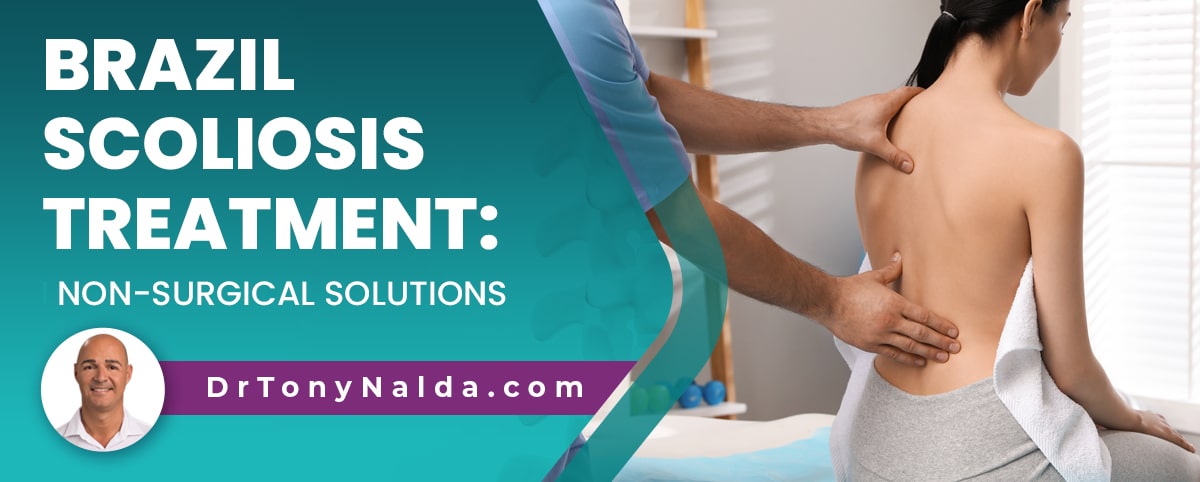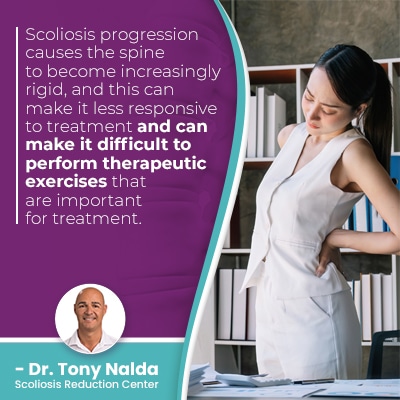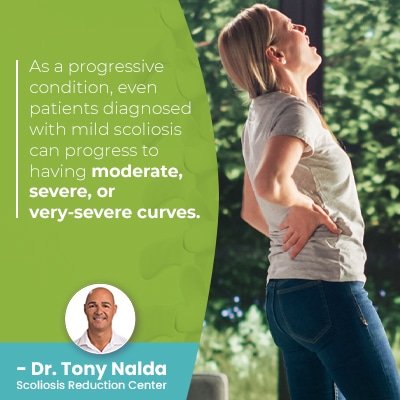Brazil Scoliosis Treatment: Non-Surgical Solutions

When treatment is more about managing an ongoing condition than curing it, as is the case with progressive conditions like scoliosis, sometimes travel is needed to put a patient within reach of the type of treatment that can improve their long-term quality of life.
A 7-hour flight from Brazil to Florida can put scoliosis patients within reach of the Scoliosis Reduction Center's unique integrative and non-surgical treatment approach. From chiropractic care to physical therapy, a number of different disciplines are applied to impact scoliosis on every level.
Scoliosis is often described as a complex condition to treat, so let's start with why.
Table of Contents
Scoliosis is Progressive
Scoliosis causes an unnatural spinal curvature to develop; in most cases, the curve will bend to the right, away from the heart, and to be considered a true scoliosis, the spine also has to rotate, making it a structural 3-dimensional spinal condition.
The nature of scoliosis is to become more severe over time, meaning the size of the unnatural spinal curve will increase over time, and this tends to make the condition more difficult to treat.
Scoliosis progression causes the spine to become increasingly rigid, and this can make it less responsive to treatment and can make it difficult to perform therapeutic exercises that are important for treatment.
Scoliosis being progressive means it's incurable, but scoliosis can be highly treatable, particularly with early detection and intervention.
As a progressive condition, the focus of treatment varies among different age groups because progression is triggered by growth, making childhood scoliosis particularly concerning as rapid progression can occur.
Growth Triggers Progression
 We don't always know what triggers a condition to develop initially, but we know it's growth that causes scoliosis to become more severe.
We don't always know what triggers a condition to develop initially, but we know it's growth that causes scoliosis to become more severe.
Scoliosis affects all ages, but is most commonly diagnosed during adolescence as adolescent idiopathic scoliosis between the ages of 10 and 18; this age group is the most at risk for rapid-phase progression because of the rapid and unpredictable growth spurts of puberty.
So counteracting the condition's progressive nature is a key focus of childhood scoliosis treatment, and in adult scoliosis treatment, progression is still a concern, but less so because the progressive trigger of growth has been removed.
So when treating adolescent idiopathic scoliosis, for example, a non-surgical treatment approach will have the goal of reducing the size of the unnatural spinal curvature and holding that reduction despite the constant trigger of growth occurring.
There Are Different Types of Scoliosis
There isn't just one type of scoliosis, which is why part of a scoliosis diagnosis involves further classifying conditions based on key variables such as condition type, and type is determined by causation.
When customizing treatment plans, they have to address a condition's underlying cause, or they are only addressing symptoms of scoliosis, and not the scoliosis itself.
The four main types of scoliosis are idiopathic scoliosis, neuromuscular scoliosis, degenerative scoliosis, and congenital scoliosis.
Idiopathic Scoliosis
Idiopathic scoliosis accounts for approximately 80 percent of known diagnosed cases, and the remaining 20 percent are associated with known causes.
A complexity of scoliosis is that there are not just different severity levels and curvature locations, but also different types whose cause will drive the focus of treatment.
In cases of idiopathic scoliosis, while we don't know why they develop, we know how to treat it, and this involves proactive treatment that's started as close to the time of diagnosis as possible.
Neuromuscular Scoliosis
My neuromuscular scoliosis patients are among the most difficult to treat because a larger neuromuscular condition like muscular dystrophy, cerebral palsy, or spina bifida, has caused the scoliosis to develop, and the larger condition has to be the focus of treatment, complicating the process.
Degenerative Scoliosis
Degenerative scoliosis affects older adults facing degenerative changes in the spine.
The cumulative effect of negative lifestyle factors can also play a role, and these can include carrying excess weight, leading a sedentary lifestyle, chronic poor posture, excessive consumption of alcohol and/or smoking, and repeatedly lifting heavy objects incorrectly.
In most cases, spinal degeneration is related to degenerative disc disease, so treatment has to focus on restoring spinal function and preventing further deterioration.
Congenital Scoliosis
Cases of congenital scoliosis involve babies born with the condition; this is caused by malformations that occur in the spine as it's developing in utero.
Treating congenital scoliosis has the obvious challenges associated with medical treatment involving patients of such a young age.
Scoliosis is also complex to treat because it ranges so widely in severity.
Mild to Severe Scoliosis
 Scoliosis treatment is shaped by a number of factors, one of which is condition severity, and this is determined by the size of the unnatural spinal curve and the angle of trunk rotation.
Scoliosis treatment is shaped by a number of factors, one of which is condition severity, and this is determined by the size of the unnatural spinal curve and the angle of trunk rotation.
Scoliosis severity is determined by a measurement taken during X-ray known as the Cobb angle, and this involves the curve's most-tilted vertebrae, and the higher a patient's Cobb angle, the more severe the condition, and the more likely it is that its effects will be noticeable:
- Mild scoliosis is diagnosed with a Cobb angle of between 10 and 25 degrees
- Moderate scoliosis involves Cobb angles of between 25 and 40 degrees
- Severe scoliosis involves Cobb angles of 40+ degrees
- Very-severe scoliosis is diagnosed at 80+ degrees
Condition severity is a key factor that treatment plans are crafted around; the goal of treatment is to reduce a patient's Cobb angle.
As a progressive condition, even patients diagnosed with mild scoliosis can progress to having moderate, severe, or very-severe curves.
Scoliosis surgery is commonly recommended at 40+ degrees for patients who are on the path of traditional scoliosis treatment.
Treating Scoliosis Without Surgery
When it comes to treating scoliosis without surgery, we're talking about conservative scoliosis treatment that has the goal of helping patients avoid invasive spinal surgery.
In light of the many complexities of treating scoliosis, it makes sense that if a treatment provider offering the type of results a patient is interested is located elsewhere to travel to access it; remember, there is no curing scoliosis, and this is why how it's treated is so important.
For patients looking for Brazil scoliosis treatment, a 7-hour flight to Orlando, Florida can mean being within reach of Dr. Tony Nalda, renowned scoliosis chiropractor, and his treatment center: the Scoliosis Reduction Center®.
Treating scoliosis without surgery means that, if successful, as much as possible of the spine's natural strength and function will be restored, and this is worked towards through an integrative approach that combines multiple different types of treatment.
In addition to the many attractions Florida has to offer that can make the distance more worthwhile, becoming a patient of the Center means having access to a number of powerful treatment disciplines under one roof.
Conservative scoliosis treatment combines condition-specific chiropractic care, physical therapy, scoliosis exercises, physical therapy, scoliosis bracing, and rehabilitation.
Conclusion
When it comes to scoliosis, deciding on a treatment approach to commit to has far-reaching effects; it will shape the spine's future health and function.
A spine that has its natural and healthy curves in place means its vertebrae are aligned and the spine is flexible, strong, and can absorb/distribute mechanical stress incurred during activity.
A spine that has lost one or more of its healthy curves needs treatment to restore the spine's biomechanics.
For residents of Brazil looking for the type of scoliosis treatment offered by Florida's Scoliosis Reduction Center® a 7-hour flight can mean accessing proactive scoliosis treatment that combines the power of chiropractic care, physical therapy, customized scoliosis exercises, bracing, and rehabilitation treatment.
Through condition-specific chiropractic care, a curvature reduction can be worked towards through a series of chiropractic adjustments and manual adjustments that can realign the spine.
Physical therapy and scoliosis exercises help strengthen the spine's surrounding muscles so they can optimally support and stabilize it and can also help improve muscle balance, posture, and activate certain areas of the brain for better communication between the brain and the rest of the body.
Corrective bracing can help in the treatment of childhood scoliosis by pushing the spine into a corrective position.
Once skeletal maturity is reached, scoliosis becomes compressive and can become painful; muscle pain, back pain, and radiating pain are the main symptoms of adult scoliosis, so pain management is a common facet of adult scoliosis treatment.
Surgical treatment of scoliosis comes with some serious potential risks, side effects, and complications so should be considered carefully.
For those interested in a more natural and less-invasive treatment method, the first step can be as simple as reaching out for guidance and/or to schedule a consultation.
Dr. Tony Nalda
DOCTOR OF CHIROPRACTIC
After receiving an undergraduate degree in psychology and his Doctorate of Chiropractic from Life University, Dr. Nalda settled in Celebration, Florida and proceeded to build one of Central Florida’s most successful chiropractic clinics.
His experience with patients suffering from scoliosis, and the confusion and frustration they faced, led him to seek a specialty in scoliosis care. In 2006 he completed his Intensive Care Certification from CLEAR Institute, a leading scoliosis educational and certification center.
About Dr. Tony Nalda
 Ready to explore scoliosis treatment? Contact Us Now
Ready to explore scoliosis treatment? Contact Us Now





